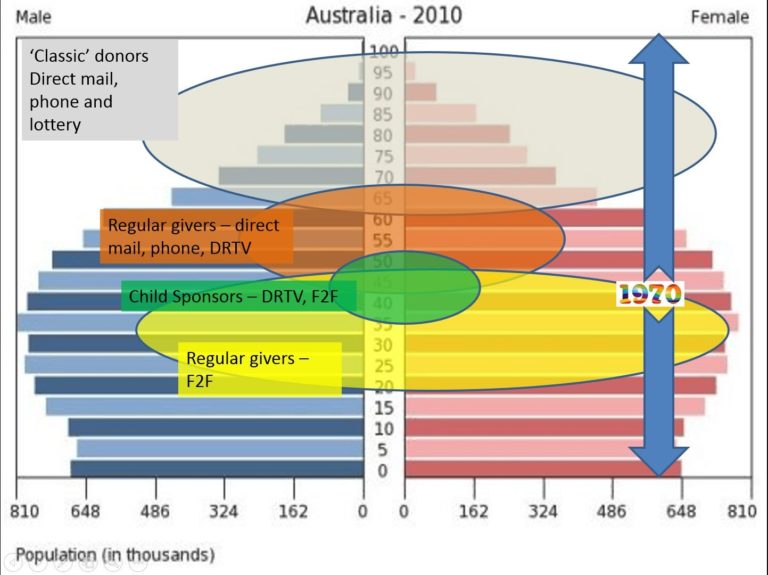Why is the this the first fundraising article featuring Matt Damon and Rachel Weisz, Simon Pegg and Uma Thurman, Naomi Campbell and Sean Triner?
It is not that they are all fundraisers. Nor is it the case that they have all dated each other. (I know that’s what you’re thinking).
The coincidence is a pure accident. They were all born in a year significant for digital fundraising.
It is likely that their first computer, like mine, looked something like the ZX81. It had 1K memory and tiny resolution.
It was the first affordable computer you could buy for £99.

Inspired by this device I have been ‘into computers’ and things digital ever since.
A big gamer, sometimes I feel life, work, and outdoor play are just things I have to do in between gaming.
I am a digital dude, an early adopter happy to yarn about the latest trend, an early tweeter, blogger, Skyper and I give all my charity donations online. I only read (and have written) ebooks.
Born in the same year as those five celebrities, I am part of the first generation of computer consumers.
I am more excited about digital than anything else in fundraising. It won’t totally replace mail, phone and face to face but it is already integrated in all.
Whether supporting mail appeals, helping generate leads for phone or welcoming a new face to face donors, digital is everywhere.
It will undoubtedly be the biggest channel of fundraising and will drive most innovation and excitement in fundraising over the coming years.
However, fundraising is ultimately about donations; typically aiming for maximum net income from fundraising investment. And so that is where I am obliged to bring in data.
Here is my theory.
The mean age of a ‘classic’ retained donor seems to vary between 64 and 74 in every country where I have looked at enough data. Of course, this may vary by charity and is influenced by the techniques used to acquire the donors. Donors begin to donate big from 55 – when mortgage is paid off, they’re earning lots and the kids have left school.
Online-acquired donors, for example, tend to be much younger. But there are not enough of them to influence the average by much. A larger pool of donors is face to face.
When we look at face to face acquired donors we see the average age is much younger. The mean age in Australia of retained face to face donors is around 42.
Face to face has had huge growth here for over a decade, and it dominates fundraising for some charities. But across the sector face to face only brings the average age down into the 60s.

Why is this relevant to digital fundraising and a celebrity list with me added to the end?
All five celebrities, plus me, were born in 1970 and, given a normal life, all would have graduated from college around 1991-1993 (Only fellow Brits Simon and Rachel graduated – Naomi, Matt and Uma were already established in their careers by then).

If you started normal work in the early 90s, you may not have realised but you were on the tipping point of a revolution.
Give or take a year or so, depending on country and employer, people starting office jobs in the 80s didn’t have a computer on the desk. People starting in the 90s did.
I was soon the cusp I did a maths degree with a fx 7000G calculator.
But within a year of work, I was tapping away in spreadsheets, realising that fundraising was all about understanding the numbers.
Most people born in (and around) 1970 were the first generation of office workers who have always worked with computers.
And we are around 46-47 right now. Except for face to face giving, we are simply not of donor age.
People born after 1970 (statistically speaking) don’t donate much. And then, when we do, we are less loyal – younger folk attrite quicker than older people and give less.

Don’t panic though. Twenty years ago, younger people didn’t give either. But when they got older they started to become more generous.
My theory is that people my age now will be giving as much as people in their mid-sixties do now. But because they have grown up with computers they will be much more likely to be donating online.
At the moment only around 9-12% of donations in Australia, USA, UK, Canada and elsewhere are made online. And a big proportion of them solicited offline.
But my bet is that by 2030 online will be the #1 channel of donations, but 2025 will be the ‘inflexion’ point.
There may be other disruptors that may speed it up. For example, the cessation of the cheque as a payment method, and the proliferation of goods and services exclusive to the online space.
But a combination of extrapolating, common sense and rational thinking tells us digital is the future.
Just not all of the future.
Best wishes,
Sean
P.S. This is a revised version of an old blog I did a few years ago. Remarkably, not much changed!










